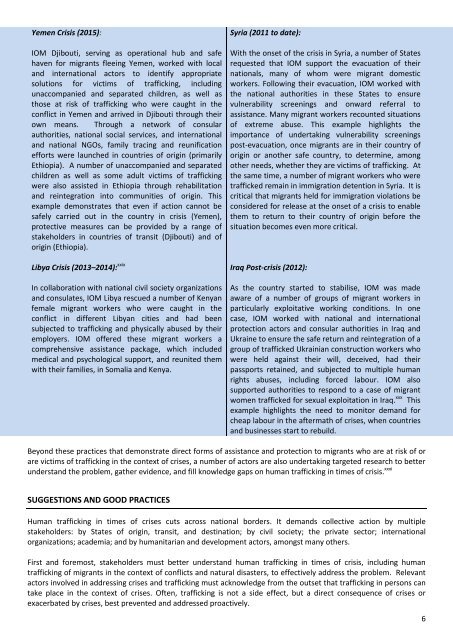Issue Brief
Trafficking%20Issue%20Brief%20final
Trafficking%20Issue%20Brief%20final
You also want an ePaper? Increase the reach of your titles
YUMPU automatically turns print PDFs into web optimized ePapers that Google loves.
Yemen Crisis (2015):<br />
IOM Djibouti, serving as operational hub and safe<br />
haven for migrants fleeing Yemen, worked with local<br />
and international actors to identify appropriate<br />
solutions for victims of trafficking, including<br />
unaccompanied and separated children, as well as<br />
those at risk of trafficking who were caught in the<br />
conflict in Yemen and arrived in Djibouti through their<br />
own means. Through a network of consular<br />
authorities, national social services, and international<br />
and national NGOs, family tracing and reunification<br />
efforts were launched in countries of origin (primarily<br />
Ethiopia). A number of unaccompanied and separated<br />
children as well as some adult victims of trafficking<br />
were also assisted in Ethiopia through rehabilitation<br />
and reintegration into communities of origin. This<br />
example demonstrates that even if action cannot be<br />
safely carried out in the country in crisis (Yemen),<br />
protective measures can be provided by a range of<br />
stakeholders in countries of transit (Djibouti) and of<br />
origin (Ethiopia).<br />
Libya Crisis (2013–2014): xxix<br />
In collaboration with national civil society organizations<br />
and consulates, IOM Libya rescued a number of Kenyan<br />
female migrant workers who were caught in the<br />
conflict in different Libyan cities and had been<br />
subjected to trafficking and physically abused by their<br />
employers. IOM offered these migrant workers a<br />
comprehensive assistance package, which included<br />
medical and psychological support, and reunited them<br />
with their families, in Somalia and Kenya.<br />
Syria (2011 to date):<br />
With the onset of the crisis in Syria, a number of States<br />
requested that IOM support the evacuation of their<br />
nationals, many of whom were migrant domestic<br />
workers. Following their evacuation, IOM worked with<br />
the national authorities in these States to ensure<br />
vulnerability screenings and onward referral to<br />
assistance. Many migrant workers recounted situations<br />
of extreme abuse. This example highlights the<br />
importance of undertaking vulnerability screenings<br />
post-evacuation, once migrants are in their country of<br />
origin or another safe country, to determine, among<br />
other needs, whether they are victims of trafficking. At<br />
the same time, a number of migrant workers who were<br />
trafficked remain in immigration detention in Syria. It is<br />
critical that migrants held for immigration violations be<br />
considered for release at the onset of a crisis to enable<br />
them to return to their country of origin before the<br />
situation becomes even more critical.<br />
Iraq Post-crisis (2012):<br />
As the country started to stabilise, IOM was made<br />
aware of a number of groups of migrant workers in<br />
particularly exploitative working conditions. In one<br />
case, IOM worked with national and international<br />
protection actors and consular authorities in Iraq and<br />
Ukraine to ensure the safe return and reintegration of a<br />
group of trafficked Ukrainian construction workers who<br />
were held against their will, deceived, had their<br />
passports retained, and subjected to multiple human<br />
rights abuses, including forced labour. IOM also<br />
supported authorities to respond to a case of migrant<br />
women trafficked for sexual exploitation in Iraq. xxx This<br />
example highlights the need to monitor demand for<br />
cheap labour in the aftermath of crises, when countries<br />
and businesses start to rebuild.<br />
Beyond these practices that demonstrate direct forms of assistance and protection to migrants who are at risk of or<br />
are victims of trafficking in the context of crises, a number of actors are also undertaking targeted research to better<br />
understand the problem, gather evidence, and fill knowledge gaps on human trafficking in times of crisis. xxxi<br />
SUGGESTIONS AND GOOD PRACTICES<br />
Human trafficking in times of crises cuts across national borders. It demands collective action by multiple<br />
stakeholders: by States of origin, transit, and destination; by civil society; the private sector; international<br />
organizations; academia; and by humanitarian and development actors, amongst many others.<br />
First and foremost, stakeholders must better understand human trafficking in times of crisis, including human<br />
trafficking of migrants in the context of conflicts and natural disasters, to effectively address the problem. Relevant<br />
actors involved in addressing crises and trafficking must acknowledge from the outset that trafficking in persons can<br />
take place in the context of crises. Often, trafficking is not a side effect, but a direct consequence of crises or<br />
exacerbated by crises, best prevented and addressed proactively.<br />
6


